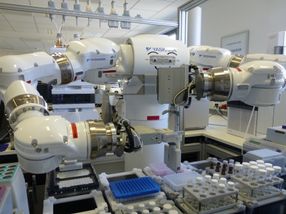Camouflage mechanism of cancer cells in Hodgkin's lymphoma decoded
Curt Meyer Memorial Prize for Dr. Stephan Mathas and Dr. Martin Janz
Cancer researchers Dr. Martin Janz and Dr. Stephan Mathas of the Max Delbrück Center for Molecular medicine (MDC) Berlin-Buch and the Charité - University Medicine Berlin, Germany, have been honored with the Curt Meyer Memorial Prize for their research on Hodgkin's lymphoma. They received the prize, worth 10,000 euros, on July 4, 2008 in Berlin for their findings published in Nature Immunology* from Professor Peter Schlag, president of the Berlin Cancer Society (Charité, MDC). Hodgkin's lymphoma, a common form of cancer of the lymphatic system, originates from white blood cells (B cells), which alter their phenotype completely and thus lose all characteristics of a B cell. Dr. Janz and Dr. Mathas succeeded in decoding the camouflage mechanisms of B cells. Based on these findings, cancer researchers hope that therapy strategies can be developed that will lead to an inhibition of cell growth or to apoptosis of the Hodgkin cells.
The phenotype of Hodgkin lymphoma cells is a riddle that has puzzled pathologists for years. It was not until 1994, some 160 years after the disease was first described by the British physician Sir Thomas Hodgkin (1832), that - using molecular biological methods - scientists discovered that the lymphoma bearing his name originates from the white blood cells, the B cells.
In their article, Dr. Janz and Dr. Mathas of the research group of Professor Bernd Dörken (MDC/Charité) were able to show that several molecular defects in the B cells are responsible for the unique phenotype of the disease. First, in Hodgkin/Reed-Sternberg cells which have evolved from the B cells, the genetic program that steers the maturation of the B cells and maintains their identity is perturbed. One of the main regulators of this program, E2A, is inhibited in Hodgkin lymphoma cells by two antagonists, Id2 and ABF-1. The researchers showed that this mechanism inhibits the gene expression pattern of B cells. Moreover, through the inhibition of E2A in Hodgkin lymphoma cells, genes are switched on that are not typical for B cell development.
Since 1988, the Curt Meyer Memorial Prize has been awarded annually by the Berlin Cancer Society to young scientists from Berlin for outstanding publications in the field of clinical and experimental oncology. The prize is named after Dr. Curt Meyer, a physician and health official of the Berlin Senate who was born in Herleshausen/Thuringia in 1891. In 1944, he was deported to Auschwitz where he as prisoner took care of fellow detainees suffering from epidemic disease. He survived the concentration camp and after the war dedicated himself to public health, including the care of cancer patients. He was the founder of several medical societies, including the Berlin State Committee against Cancer out of which the Berlin Cancer Society has evolved. Curt Meyer died in 1984 at the age of 93.
*Intrinsic inhibition of E2A by ABF-1 and Id2 mediates reprogramming of neoplastic B cells in Hodgkin lymphoma
Most read news
Topics
Organizations
Other news from the department research and development

Get the analytics and lab tech industry in your inbox
By submitting this form you agree that LUMITOS AG will send you the newsletter(s) selected above by email. Your data will not be passed on to third parties. Your data will be stored and processed in accordance with our data protection regulations. LUMITOS may contact you by email for the purpose of advertising or market and opinion surveys. You can revoke your consent at any time without giving reasons to LUMITOS AG, Ernst-Augustin-Str. 2, 12489 Berlin, Germany or by e-mail at revoke@lumitos.com with effect for the future. In addition, each email contains a link to unsubscribe from the corresponding newsletter.


























































